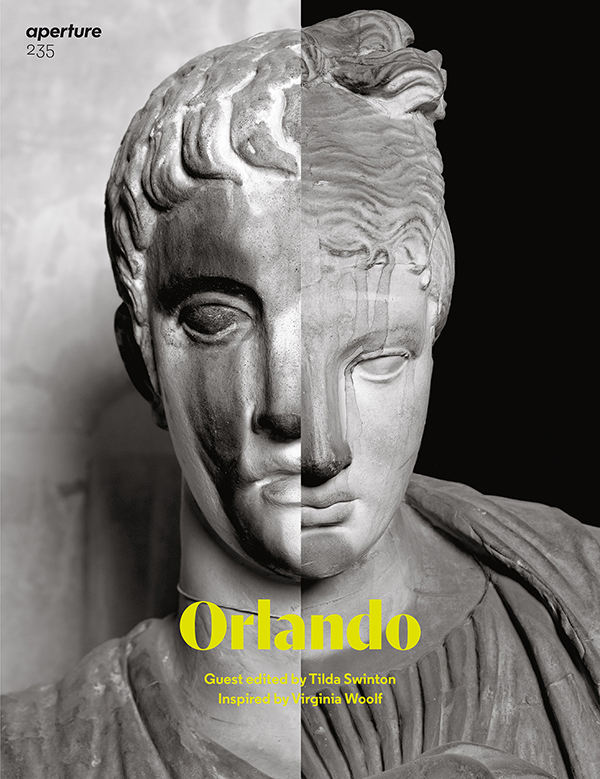Tilda Swinton Guest Edits Aperture’s “Orlando” Issue

Viviane Sassen, from the series Venus & Mercury, 2019
© the artist and courtesy Stevenson, Cape Town and Johannesburg. All sculptures belong to Musée du Louvre and Château de Versailles
Virginia Woolf’s novel Orlando (1928), perhaps the author’s most whimsical, begins as a tale of a young nobleman in the age of Queen Elizabeth I. Orlando, improbably, lives for centuries and along the way mysteriously shifts gender, a radical plot point that is rendered—in an even more radical gesture—as a nonevent. After having Orlando traverse time and geographies, Woolf concludes the narrative in her present day, October 1928, on the eve of the book’s publication.
In 1992, director Sally Potter adapted the novel for the screen and cast Tilda Swinton, the guest editor of Aperture’s summer issue, in the role of Orlando. The film version, like all translations of a story from one medium to another, takes its liberties, extending Orlando’s life decades further, leaving her in the early 1990s.
With this issue, Swinton continues that journey.
She calls upon Woolf’s central themes—gender fluidity, limitlessness, and the deep perspective that is earned from a long life—and connects them to our present day. The film Orlando arrived at a moment when debates around identity, representation, and society shook the culture, notably with the controversial 1993 Whitney Biennial, referenced in a conversation between writer Maggie Nelson and artist Shannon Ebner. Those debates still resound as a new generation of photographers push to challenge institutions and representational codes, insisting on their own narratives, their own visions.
In “Orlando,” we move through portals and across time. Reflections by the acclaimed authors Michael Cunningham, Marina Warner, and Lynne Tillman underscore the prescience of Woolf’s playful experiment from the 1920s, while filmmakers and critics Sally Potter, Isaac Julien, and B. Ruby Rich—who, along with the iconoclastic auteur Derek Jarman, defined queer cinema aesthetics in the 1980s and ’90s—consider the power of rendering narratives like Orlando on-screen. Lynn Hershman Leeson melds art making and futurism. And Viviane Sassen approaches classical statues at Versailles as if they were living subjects, creating hybrid bodies for her newest series Venus & Mercury (2019). “I try to make images that have the ability to free your mind in some way and to look at something from a different perspective,” Sassen says. “My images are like a hall of mirrors; they reflect back at you what you already have inside.”
At Swinton’s prompting, a group of artists made work expressly for this issue. Mickalene Thomas’s Orlando-inspired portraits unite fashion, the classical muse, and nineteenth-century painting. Paul Mpagi Sepuya confronts the depiction of the Moor on the first page of Woolf’s book. Elle Pérez, channeling Woolf’s devotion to her lover Vita Sackville-West, for whom Orlando was written, makes portraits that read as love letters to fellow artists. Carmen Winant assembles collages that layer the images Woolf originally selected to illustrate the pages of Orlando. Jamal Nxedlana travels through Johannesburg with the gender binary–flouting artist duo FAKA. And Walter Pfeiffer and Collier Schorr delve into their own archives to create revealing new image sequences of bodies in states of youthful transition.
“Woolf wrote Orlando,” Swinton notes, “in an attitude of celebration of the oscillating nature of existence. She believed the creative mind to be androgynous. I have come to see Orlando far less as being about gender than about the flexibility of the fully awake and sensate spirit. This issue of Aperture will be a salute to limitlessness, and a heartfelt celebration of the fully inclusive and expansive vision of life exemplified by the extraordinary artists collected here.”
Today, when many are turning inward, or calling for borders, when suspicion abounds about those unlike ourselves, a story such as Orlando, which celebrates the expansiveness and possibilities of human experience, is a much-needed parable.
Pre-order Aperture, issue 235, “Orlando,” or subscribe to Aperture and never miss an issue. “Orlando,” an exhibition guest-curated by Tilda Swinton, is on view at Aperture Gallery from May 24–July 11, 2019.























